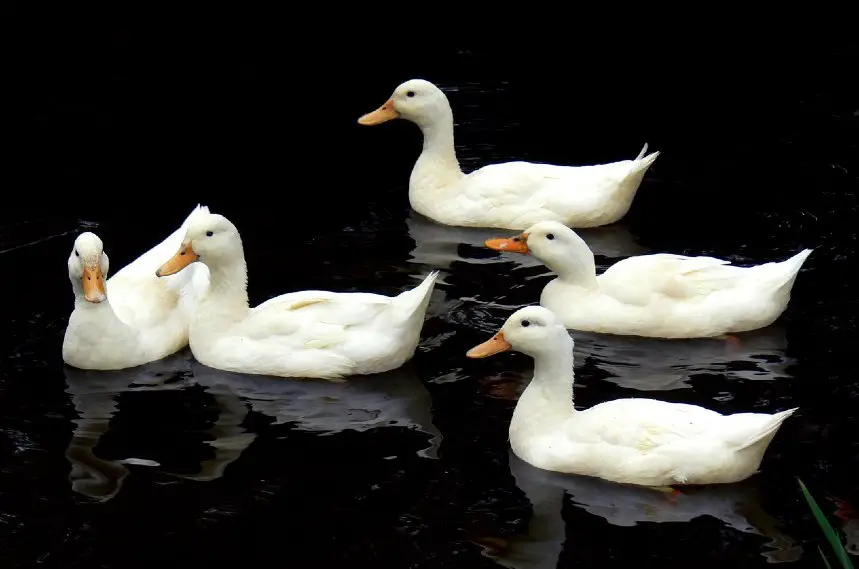If you look at a picture of the Aylesbury Duck, then the look may seem familiar, right? That is one of the most popular duck breeds in the world, yes? Well, not quite!
You see, the Aylesbury Duck looks the same as another duck, which we are going to talk about shortly. The Aylesbury Duck is actually one of the rarer breeds out there. Shall we take a look?

Facts at a Glance
| Eggs | 35 – 125 eggs per year |
| Egg shell color | White, Pale green |
| Size | Male: 10 lbs. Female: 9 lbs. |
| Foraging | Good |
| Temperament | Calm |
| Status | Uncommon |
| Origin | England |
Where Do Aylesbury Ducks Come From?
Sadly, there isn’t that much information with regard to the origin of the Aylesbury Duck. As with most breeds a few centuries ago, there were no breeding records kept. The breed just popped out of nowhere in 1845 on the first poultry show in London. It was recognized by the American Poultry Association in 1874.
The duck had been raised in the same area since the 1600s, although at that time it was called the English White. The name Aylesbury Duck stuck because of, well, the town that the breed was developed in, a town 40 miles north of London.
We are not going to go into depth on everything about the Aylesbury Duck. There has been a lot of ups and downs in the history of this domesticated duck breed. A lot of them. However, it was pretty much raised for meat from the 17th century through to about the 20th century.
Most of this farming would have taken place around the Aylesbury area. Interestingly, the commercial nature of this duck wasn’t so much focused on massive farms breeding them and culling them.
Instead, the eggs would have been sold onto individuals who would raise the ducks themselves.
So, what is the duck that replaced it? Well, incidentally, it was the Pekin Duck. The one that looks pretty much the same as the Aylesbury Duck. The only difference is the color of the beak.
The Pekin Duck has a yellow beak instead. The meat does taste a lot worse on the Pekin Duck, but they are easier to raise.

Of course, the commercial duck industry was dying out at pretty much the same time, and thus the Aylesbury Duck wasn’t raised nearly as much.
You can still find them about, but they are raised by homesteaders and the like. It is doubtful you will find many commercial operations that are raising the Aylesbury Duck.
The Appearance
This is a white feathered duck. It does not come in any other color. The skin of the duck is white, which is actually something that is incredibly rare to find. The beak is also white, hence why it is easy to tell the difference between this duck and the Pekin Duck.
Apart from this, it is your stereotypical duck. A decent body. In fact, this is a duck that is a little bit on the chunkier side of things, which is one of the main reasons as to why the Aylesbury Duck is raised as a meat bird.
Aylesbury Duck Eggs
Obviously, duck eggs are not consumed in any sort of quantity compared to years gone by. However, the Aylesbury Duck can produce a decent number of eggs. Around 100 eggs per year.
So, you should be able to get a few of them each week, and they do taste absolutely delicious. This isn’t the best duck in the world to raise for eggs, but at least you get a few!
Aylesbury Duck Meat

Weighing 9 lbs or more, the Aylesbury Duck has pretty much always been designed to be a meat duck. If there were not ‘better’ birds in recent years, we have no doubt that the Aylesbury Duck would still be raised as a meat bird. It is a good amount of chunk, and the taste of it is incredibly delicious.
If you are a homesteader, then you are going to have very, very few issues if you want a quality meat bird. Perhaps the only problem is the fact that they can be a bit tougher to breed, but this is OK. They do breed, it just takes a bit more effort.
The duck is ready to be slaughtered at about 9-weeks old, which means it is one of the faster duck breeds to mature for slaughter.
As a Feather Bird
Obviously, duck feathers do not quite have the same demand that they had in the past. However, if you do want a bird that produces some stunning looking feathers, then the Aylesbury Duck is probably one of the best birds there is.
The white feathers really stand out, and they are ridiculously soft. Although, of course, you do need to make sure that you treat the duck well or it is going to have feathers that lose that white shine.
The Friendly Personality of the Duck
This is a friendly bird, but that is about it. If you are looking for a bird that is fun to watch, then the Aylesbury Duck is probably not going to be the right option for you. This is a bird that doesn’t enjoy moving around, if at all.
So, this means no foraging or anything like that. This can actually cause a few issues in the long term, but since you are likely going to be using them for slaughter at 9-weeks, this isn’t that much of a problem.
Aylesbury Duck Care Tips
If you want a show bird, then the Aylesbury Duck is tough to raise. You need to feed it the right diet, and it can’t go out in the sun.
If it goes out in the sun, then the feathers and beak will start to change color and it is no longer going to be a show quality duck which, of course, you do not want to have happen.
If you are just generally raising the birds, then you will need to take control of their diet a little bit better. This is because they are not moving around all that much.
For this reason, people will tend to purchase quality food pellets for the duck. Since the duck will not be foraging all that much, you need to ensure that they have as much nutrition as possible in the pellets.
See also:
– Ancona Duck
– Welsh Harlequin Duck

Pingback: Guide to Duck Breeds and Types - List Of All Domestic Ducks in US